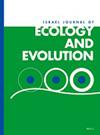Oviposition responses of two mosquito species to pool size and predator presence: varying trade-offs between desiccation and predation risks
IF 0.8
4区 环境科学与生态学
Q3 ECOLOGY
引用次数: 11
Abstract
Natural selection is predicted to favor females that can detect risks of desiccation and predation when choosing among temporary pools for oviposition. Pool size may serve both as a cue for desiccation risk and as a predictor for future colonization by predators or for the probability of present, undetected predators. Therefore, oviposition responses to pool size are expected to interact with the presence of predators that can be detected. We measured oviposition by two mosquito species, Culiseta longiareolata and Culex laticinctus, in a mesocosm experiment, crossing two pool surface sizes with presence or absence of the hemipteran predator, Notonecta maculata, which is chemically detectable by mosquitoes. Both mosquito species strongly avoided Notonecta pools. Using a mechanistic statistical model, we accounted for the higher encounter rate of females with larger pools, and determined their true oviposition preferences for pool size. C. laticinctus showed a clear preference for larger pools, but C. longi...两种蚊子对池大小和捕食者存在的产卵反应:在干燥和捕食风险之间的不同权衡
据预测,在选择临时产卵池时,自然选择倾向于能够察觉到干燥和被捕食风险的雌性。池的大小既可以作为干燥风险的线索,也可以作为未来捕食者殖民的预测器,或者是目前未被发现的捕食者的可能性。因此,产卵对池大小的反应预计与可以检测到的捕食者的存在相互作用。在一项中观实验中,我们测量了两种蚊子的产卵量,长areolata库蚊和laaticinctus库蚊,在两种不同大小的水池表面存在或不存在半翅目捕食者斑纹纹蚊(Notonecta maculata),蚊子可以在化学上检测到它。这两种蚊子都强烈地避开了nottonecta池。利用一个机制统计模型,我们解释了雌性与更大的池相遇率更高,并确定了它们对池大小的真实产卵偏好。白桦对较大的池有明显的偏好,而白桦对较大的池有明显的偏好。
本文章由计算机程序翻译,如有差异,请以英文原文为准。
求助全文
约1分钟内获得全文
求助全文
来源期刊

Israel Journal of Ecology & Evolution
环境科学-进化生物学
CiteScore
2.10
自引率
0.00%
发文量
7
审稿时长
>36 weeks
期刊介绍:
The Israel Journal of Ecology and Evolution includes high-quality original research and review papers that advance our knowledge and understanding of the function, diversity, abundance, distribution, and evolution of organisms. We give equal consideration to all submissions regardless of geography.
 求助内容:
求助内容: 应助结果提醒方式:
应助结果提醒方式:


